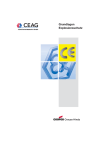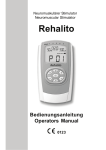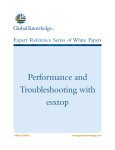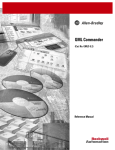Download OPERATING INSTRUCTIONS EUROTEST 701/702 S EUROTEST
Transcript
m co . k ni o r kt e el s j .h w ww EUROTEST EUROTEST 701/702 S OPERATING INSTRUCTIONS ( Version "A3/C/S2" ) EUROTEST 701/702 S (A3/C/S2) 1 © HJS ELEKTRONIK TABLE CHAPTER/PAGE 2 FUNCTIONAL ELEMENTS 3 SAFETY PRECAUTIONS 4 UTILITZATION 4 SAFETY ELEMENTS 4 LITERATURE 5 MEASUREMENTS: PROTECTIVE CONDUCTOR RESISTANCE R-PE 6,7 INSULATION RESISTANCE R-ISO 8,9 PROTECTIVECONDUCTORCURRENTI-SL (direct method) 10 PROTECTIVECONDUCTORCURRENTI-SL (equ.leakage curr.method) 11 TOUCH CURRENT I-BR (direct method) 12 TOUCH CURRENT I-BR (equ. leakage curr. method) 13 TECHNICAL SPECIFICATION 14 LIMITS +DISPLAY OF LIMIT VALUES 15 DISPLAY OF MEASUREMENT VALUES 15 GENERAL INFORMATION Es irrt der Mensch solang er strebt jwg 15,16 REPAIR SERVICE 16 CALIBRATION SERVICE 16 DATA INTERFACE 16 WARRENTY 16 CALIBRATION RECORD 17 MADE IN GERMANY ...we do our very best 2 EUROTEST 701/702 S (A3/C/S2) © HJS ELEKTRONIK FUNCTIONAL ELEMENTS DESCRIPTION OF FUNKTIONSELEMENTE (1) MEASURING INSTRUMENT (2) Test socket for R-PE, R-ISO, and I-EA measurement. (3) Mains connector. (4) Test lead w. crocodile clip for R - PE measurement. (The line resistance is length independently compensated for > fourpole measurement) (5) PLL-controlled LCD for display of values. (5') Limit display, 3 LEDs per measurement range (6) Range selector. (7) I-ABL terminal for leakage current measurement. (8) L/N terminal for R-ISO and I-EA measurement. Connected to the test socket (2) via the outer conductors L and N . (9) PEi terminal for R-PE measurement only . Connected to PE in the test socket (2) . (9') R-ISO, and I-EA. PEu terminal for R - PE, measurement. Connected to PE in the test socket (2). (10) Test lead with probe tip. (11) Test lead with probe tip. (12) KROKO terminal for R-PE measurement. (13) Data interface to PC or notebook (14) Switch for (de)activating the PE in the test socket. Z2 insulating pad for tester and test sample. Z3 Test adapter for R-PE, R-ISO, and I-EA measurement. (CEE 3L/N/PE on earthing-contact type L/N/ PE) (i.V.) ACCESSORIES (OPTIONAL) Z0.1 Software set: WINDOWS analysis program + interface adaptor (Z0.2) for the preparation of test record. Z4 Test adapter with RCD for leakage current measurement. (3 - ph.: CEE 3L/N/PE on CEE 3L/N/ PE)(i.V.) Z1 Test adapter with RCD, for leakage current measurement. (1- ph.: earthing-contact type L/N/PE on earthing-contact type L/N/PE) Z5 Set of test leads: lead with crocodile clip , as (4), but 2 m long + Y adapter (Z6) for bridging longer distances between the measurement points. EUROTEST 701/702 S (A3/C/S2) © HJS ELEKTRONIK 3 SAFETY SAFETYPRECAUTIONS Before taking the INSTRUMENT into operation, make sure that the instrument's nominal voltage matches the mains voltage. The INSTRUMENT serves for electronically testing electrical devices in accordance with DIN VDE 0701/ DIN VDE 0702. It has been manufacutured and tested as defined in DIN VDE 0404, DIN EN 61010, DIN EN 61557, and has been shipped in a safety technological perfect condition. To maintain this conditition and ensure a safe operation, the user has to observe the warnings and notes included in these operating instructions : ATTENTION This INSTRUMENT may be exclusively used for electrical testings. Please note that the respective standards may require additional manual and visual inspections, temperature, functional, and drop tests etc. depending on the type of test sample. ATTENTION The INSTRUMENT may be exclusively connected to an intact and safe 230V AC mains. The mains socket must provide for an intact connection of the protective conductor (earthing -contact type PE). ATTENTION A voltage supply to the PE at the mains socket may result in incorrect leakage current measurements. ATTENTION At a faulty power supply, the INSTRUMENT and the test sample are to be immadiately disconnected from the mains. ATTENTION Using the INSTRUMENTS for measurements in electrical equipments is not permissible. ATTENTION Carrying out measurement in the immediate vicinity of electrical or electromagneticfieldsaswellasHF-emittingdevicesorequipmentshouldbe avoided. 4 EUROTEST 701/702 S (A3/C/S2) ATTENTION Please account for the occurence of unexpected voltages at the test samples. The anti-radio-inference-capcitor may be charged after the insulation resistance has been measured. Please, always check the test sample's protective conductor resistance R - PE first . Without an intact connection of the protective conductor to the test sample the results of an insulation resistance and protective conductor current measurement are meaningless. If a safe operation of the INSTRUMENT seems to be no longer ensured the INSTRUMENT is to be taken out of operation and has to be protected against accidental use. It is to be assumed that a safe operation of the INSTRUMENT is no longer ensured if the INSTRUMENT > > > > is visibly damaged, does not work any more, has been stored under unfavourable conditions, has been subject to heavy strain during transport. UTILIZATION The INSTRUMENT is exclusively suited for the testing and measurement on repaired or modified electrical devices as set out in DIN VDE 0701 and for repetitive testings according to DIN VDE 0702 . Following these provisions i.a. the protective conductor resistance R - PE, the insulation resistance R - ISO, the protective conductor current I - SL, the touch current I - BR and the non prevailence of stress I - SF (T240) is to be tested. PROTECTIVE ELEMENTS The INSTRUMENT features a PE connector for the protective conductor and is therefore rated protection class I. ThePE connector is only needed for the leakage current measurement (direct method). In the I - ABL position, it is connected to the INSTRUMENT's chassis via reversible protective elements. In case of overload voltages of more than 253 V all 3 limit LEDs will start flashing signalling the reponse of the protective elements. In all other switch positions the INSTRUMENT is galvanically disconnected from the mains. © HJS ELEKTRONIK L I T E R A T U R E REFERENCE STANDARDS SUGGESTED READING VDE 0100 Teil 200 Errichten von Starkstromanlagen mit Nennspannungen bis 1000 V Bödeker: Prüfung ortsveränderlicher Geräte, Verag Technik VDE 0104 Errichten und Betreiben elektrischer Prüfanlagen Bödeker: Der Prüfplatz in der Elektrowerkstatt, Verag Technik VDE 0105 Teil 100 Betrieb von elektrischen Anlagen VDE 0106 Teil 1 Schutz gegen elektrischen Schlag Bödeker, Kindermann, Kammerhoff, Matz: Prüfung elektrischer Geräte nach DIN VDE 0701, 0702, VDE 0751 Anwendung in der Praxis VDE-Verlag (08-2001) VDE 0404 Teil 1 Allgemeine Festlegungen VDE 0404 Teil 2 Geräte für Wiederholungsprüfung. Bödeker, Kindermann: Fachpublikationen zum Thema: VDE 0411 Sicherheitsbest. für el. Messgeräte VDE 0413 Geräte zum Prüf. v. Schutzmaßnahmen VDE 0701 Teil 1 Allgemeine Anforderungen VDE 0701 Teil 2 Rasenmäher und Gartenpflegegeräte VDE 0701 Teil 3 Bodenreinigungsgeräte und Maschinen VDE 0701 Teil 4 Sprudelbadgeräte VDE 0701 Teil 5 Großküchengeräte VDE 0701 Teil 6 Ventilatoren und Dunstabzugshauben VDE 0701 Teil 7 Nähmaschinen VDE 0701 Teil 8 Ortsfeste Wasserwärmer VDE 0701 Teil 200 Netzbetriebene elektronische Geräte VDE 0701 Teil 240 Datenverarb-Einrichtg u.Büromasch. VDE 0702 Teil 1 Wiederholungsprüfungen VDE 0711 Teil 1 Leuchten, allgemeine Anforderungen VDE 0751 Teil 1 Wiederholungsprüfungen von med. elektrischen Geräten VDE 0805 Sicherheit von el. Büromaschinen VDE 1000 Teil 10 DIN EN 13306 Prüfung el. Geräte nach Instands.. ep 09/2000 Kennwerte für den Ableitstrom...... de 09+10/2000 Prüfgeräte nach DIN VDE 0404.... ep 09/1999 Pflicht zur Wiederholungsprüfung.. ep 01/2000 Umfang zur Wiederholungsprüfg... ep 02/2000 Wiederholungsprüfg nach VBG4... ep 03/2000 PC: - ortsfest oder ortsveränderl..?.. ep 09/2000 L-Stromzange u.Fehlerstrommessg. ep 12/2000 Messung des Ersatz-Ableitstroms de 01/2001 Prüfplätze ohne Berührungsschutz ep 04/2001 Egyptien: Unterweisung in der Elektropraxis Verlag Technik Jeiter: Das neue Gerätesicherheitsgesetz, Verlag C.H.Beck ZVEH (Hrsg): Handwerksordnung, Verlag Heider Honig: Handwerksordnung, Kommentar, Verlag C.H.Beck Anforderungen an die im Bereich der Elektrotechnik tätigen Personen Gothsch: VBG4, Elektrische Anlagen und Betriebsmittel, BG F+E (Hrsg), Köln Begriffe der Instandhaltung Rosenberg VDE-Prüfung nach VBG4/VDE-Verl. EUROTEST 701/702 S (A3/C/S2) © HJS ELEKTRONIK 5 MEASUREMENT: PROTECTIVE CONDUCTOR RESISTANCE R-PE MEASUREMENT: PROTECTIVE CONDUCTOR RESISTANCE R-PE (Sample connections fig. 1, 2, and 3 ) Figure 1 Test Sample Protection Class I The protective conductor resistance R - PE must not be measured until after a visual inspection of the instrument and all parts representing a possible electrical or mechanical danger or risk of fire! As for instruments classified protection class I the low ohm passage of the PE between the test sample's PE output and its housing or all touchable and conductive parts connected to the PE is measured. > The test sample may be "in operation" or diconnected from mains. > During this measurement, the power cord has to be sectionwise moved over the entire length especially near the connection points. > Please note that with hard-wired devices and/or such being "in operation" parallel earth connections and protective conductor currents may negatively affect the measurement results. The line resistances of the test leads are length independently compensated for (fourpole measurement), however, if adapters or adapter leads are used this compensation is ineffective. Therefore, we recommend to determine the adapter leads' resistance before measuring the R - PE and to account for this value when documenting the measurement results. If the protection class I test sample features no mains plug - e.g. stationary devices - or if the plug does not match the test socket, the measurement can be made using the terminals PEi+PEU . In this case, the PE in the test socket has to be deactivated via the selector (14) . Alternatively to the test leads supplied the test lead with crocodile clip (Z5) and the Y-adaptor (Z6) should be used for bridging larger distances between the measurement points. For limits and the display of limit values please refer to: page 15 6 EUROTEST 701/702 S (A3/C/S2) Selector Position: R-PE Test sample with mains plug Test sample "out of operation" © HJS ELEKTRONIK MEASUREMENT: PROTECTIVE CONDUCTOR RESISTANCE R-PE Figure 2 Figure 3 Test Sample Protection Class I Test Sample Protection Class I extension cord Selector position: R-PE Selector position: R-PE Test sample with mains plug Exception: Interruption impossible Test sample "out of operation" Test sample "in operation" EUROTEST 701/702 S (A3/C/S2) © HJS ELEKTRONIK 7 MEASUREMENT: INSULATION RESISTANCE R-ISO MEASUREMENT: INSULATION RESISTANCE R-ISO (Sample connection figure 4, 5, and 6) Figure 4 Test Sample Protection Class I The R-ISO is measured as follows: a) for protection class I devices: between the test sample's PE connector and all active parts, b) for protection class I devices between all active parts as well as all touchable conductive parts not being connected to PE . c) for protection class II devices: between all active parts as well as all touchable conductive parts or such being connected to the housing. > The test sample is "out of operation" but switched on. > Devices to be used in water must (or can) be covered with water during the measurement ! (see standards) > The measurement is to be made in all switch positions (step-by-step systems, relays, controllers, temperature switches etc.) . > The correct measurement value is the smallest ! value measured. > 500 VDC test voltage! Touching the test lead tips may result in shock reactions poses, however, no hazard at all! If the protection class I or II Prüfling has no mains plug - e.g. stationary devices - or if the plug does not match the test socket, the measurement can also be made via the terminals PEU + L/N . (Applies analogously to polyphase test samples) If the measurement is carried out in accordance with b) on protection class I devices with an earthing -contact type plug, the PE in the test socket has to be deactivated via the selector (14). For limits and the display of limit values see page 15 Selector position: R-ISO Exception: test sample without mains plug Test sample "out of operation" but switched on 8 EUROTEST 701/702 S (A3/C/S2) © HJS ELEKTRONIK MEASUREMENT: INSULATION RESISTANCE R-ISO Figure 5 Figure 6 Test Sample Protection Class II Test Sample Protection Class I Selector position: R-ISO Selector position: R-ISO Test sample with mains plug Exception: hard-wired DS test sample Test sample "out of operation", but switched on Test sample "out of operation" but switched on Attention: Set test sample stress-free! EUROTEST 701/702 S (A3/C/S2) © HJS ELEKTRONIK 9 MEASUREMENT: PROTECTIVE CONDUCTOR CURRENT I-SL MEASUREMENT: PROTECTIVE CONDUCTOR CURRENT I-SL (direct method*) (Sample connections: figure 7) Figure 7 Test Sample Protection Class I If operated set out herein, the protection conductor current I-SL is a leakage current of a protection class I device flowing via the insulation and protective conductor to the earth. The measurement has to be made if there is no other chance to ensure that all parts affected by the mains voltage have been tested during the R - ISO measurement of if the R - ISO test has not been passed or carried out. Page 15! > Test sample and INSTRUMENT are connected to the same circuit. > During this measurement, the test sample is "in operation"! > If possible, the measurement is made in all! plug positions of the test sample's mains plug and in all selector positions (step-by-step systems, relays, controllers, temperature switches etc.). The correct measurement value is the highest value measured. > The test sample must be set insulated! Except for the power cord no other conductive connections to other devices or the earth potential may be made. Measuring the protective conductor current I-SL using this direct method should be made using the measurement adapter (Z1) with integrated RCD because of the dangers resulting from touching possibly defect test samples. Connect the test lead with the adapter first and then the adapter/test sample to the mains. *) This method is also called "direct method " since the test circuit is directly connected to the mains. Using the direct measurement method for the exclusive documention of the test sample's insulating capacity is permissible. For limits and the display of limit values see page 15 Selector position: I-ABL Test sample with mains plug Test sample "in operation" Measurement made using the direct method 10 EUROTEST 701/702 S (A3/C/S2) © HJS ELEKTRONIK MEASUREMENT: PROTECTIVE CONDUCTOR CURRENT I-SL Figure 8 Test Sample Protection Class I MEASUREMENT: PROTECTION CONDUCTOR I-SL (equivalent leakage current method*) (Sample connection figure 8) If the protective conductor current I-SL is measured using the "equivalent leakage current method ", the R-ISO test has to be passed first! This measurement is made: on protection class I devices: between the test sample's PE-connector and all active parts. > The test sample is "out of operation" but switched on. > The measurement is made in all selector positions (stepby-step systems, relays, controllers, temperature switches etc.). The correct measurement value is the highest value measured. > As for test samples with switches controlling all poles and symetric capacitive power input, the measurement values may be divided by 2! (See standard) If the protection class I test sample has no mains plug - e.g. stationary devices - or if the plug does not match the test socket, the measurement can be made using the terminals PEU + L/N . (Applies analogously to polyphase test samples) *) When using the "equivalent leakage current method" the test circuit is not directly connected to the mains and the "leakage current" is generated by the INSTRUMENT. The word "equivalent" refers to the fact that in this test an artifical mains network is simulated. Selector position: I-EA This method has its advantages and disadvantages. The advatages: The test setting is small, cost efficient, simple and safe application as well as a high reproductivity of the measurement values. The disadvantages: The test can only be made if the R-ISO test has been passed and all switches can be switched on.. For limits and the display of limit values see page 15 Test sample with mains plug Test sample "out of operation" but switched on Measurement using the eq. leakg. current method EUROTEST 701/702 S (A3/C/S2) © HJS ELEKTRONIK 11 MEASUREMENT: TOUCH CURRENT I-BR MEASUREMENT: TOUCH CURRENT I-BR (direct method*) (Sample connection figure 9) Figure 9 Test Sample Protection Class I The touch current I-BR is a leakage current generated at proper operation of the device. It flows through the insulation, touchable conductive parts and the person touching them to the ground. The measurement is made if it can not be ensured that all parts affected by the mains voltage have been covered in the R - ISO test or if the R - ISO has not been passed or carried out. The touch current is measured: Page 15! a) with protection class I devices: on all touchable conductive parts not being connected to the PE , b) with protection class II devices: on all touchable conductive parts. > Test sample and INSTRUMENT are connected to the same circuit. > During the measurement the test sample is "in operation"! > If possible, the measurement is made in all! plug positions of the test samples's mains plug and in all selector positions (step-by-step systems, relays, controllers, temperature switches etc.). The correct measurement value is the highest value measured. > The test sample must be insulated! Except for the power cord no other conductive connections to other devices or the earth potential may exist. Measuring the touch current I-BR using this direct method should be made using the measurement adapter (Z1) with integrated RCD because of the dangers resulting from touching possibly defect test samples. Connect the test lead with the adapter first and then the adapter/test sample to the mains.. *) This method is also called "direct method " since the test circuit is directly connected to the mains. Using the direct measurement method for the exclusive documentation of the test sample's insulation capacityis permissible. Selector position: I-ABL Test sample with mains plug Test sample "in operation" For limits and the display of limit values see page 15 Measurement using the direct method 12 EUROTEST 701/702 S (A3/C/S2) © HJS ELEKTRONIK MEASUREMENT: TOUCH CURRENT I-BR Figure 10 Test Sample Protection Class II MEASUREMENT: TOUCH CURRENT I-BR (equivalent leakage current method*) (Sample connection figure 10) If the touch current I-BR is measured using the "equivalent leakage current method" the R-ISO test must have been passed first! The touch current I-BR is measured: a) with protection class I devices: between all active parts as well as all touchable conductive part not being connected to the PE, b) with protection class II devices: between all active parts as well as all those being in contact with the housing or being touchable and conductive respectively.. > The test sample is "not in operation" but switched on. > The measurement is to be made in all selector positions (step-by-step systems, relays, controllers, temperature switches etc.) .The correct measurement value is the highest value measured. > As for test samples with switches controlling all poles and symetric capacity power input, the measurement values may be devided by 2! (See standard) If the protection class I or II test sample has no mains plug -e.g. stationary devices - or if the plug does not match the test socket, the measurement can also be made using the terminals PEU + L/N . (Applies analogously to polyphase test samples) If the measurement on protection class I devices with earthing-contact type plug is made in accordance with a) the PE in the test socket has to be deactivated via the selector (14) . Selector position: I-EA Test sample with mains plug Test sample "out of operation", however, switch on *) When using the "equivalent leakage current method" the test circuit is not directly connected to the mains and the "leakage current" is generated within the INSTRUMENT . (also see p. 11) NOTE: In DIN VDE 0701 part 240 the touch current I-BR is called "stress-free I-SF" ! For limits and the display of limit values see page 15. Measurement using the eq. leakg. current method EUROTEST 701/702 S (A3/C/S2) © HJS ELEKTRONIK 13 TECHNICAL SPECIFICATION NOMINAL CONDITIONS OF USE MEASUREMENT RANGE R-PE ENVIRONMENT 0 .....19,99 MΩ max. 600 VDC max. 5 mA +- 2,5% +2D + - 10% +2D 253 V permanet POWER MEASUREMENT RANGE R-ISO Nominal range of use open-circuit voltage Short-circuit current Intrinsic error M. 1) 2) Operating error M. 2) Overload value Overload time MEASUREMENT RANGE I-EA (Eq. Leakg. Cur. Method) Nominal range of use Open-circuit voltage Short-circuit voltage Reference voltage / Ri / Rref Intrinsic error M. 1) 2) Operating error M. 2) Overload value Overload time 0......19,99mA max. 40 VAC max. 2 mA 230 VAC /~20 K / ~2 K +- 2,5% +2D + - 10% +2D 253 V permanent MESAUREMENTRANGEI-ABL(DirectMethod) Nominalrangeofuse Method / Ri Intrinsic error M. 1) 2) Operating error M. 2) Overload value Overload time Nominal voltage Nominal frequency Curvature Ambient temperature 0......19,99 Ω max. 20 VAC max. 350 mA +- 2,5% +2D + - 10% +2D ./. ./. Nominal range of use Open-circuit voltage Short-circuit current Intrinsic error M. 1) 2) Operating error M. 2) Overload value Overload time 0......3,99mA direct, AC+DC /~2 K + - 2,5%+2D + - 10% +2D 253 V permanent Temp. storage Temp. operation Accuracy Humidity Climate class Height above sea level Application 207 V ... 253 V 48 Hz ... 52 Hz < 10 VA ELECTRICAL SAFETY Protection class I (one) Nominal voltage 230 V Test voltage 3,7 KV Overvoltage category II Degree of soiling 2 EMV: emmittance of/immunity from noise acc. DIN EN 61326 MECHANICAL CONSTRUCTION Display LCD 3,5 - 13 / PLL gest. Display of m. values 3LEDinallmeasurementranges Protection class Housing IP 40, Conn. IP 20 Dimensions/weight w/o leads 100x195x40mm/~500g DATA INTERFACE REFERENCE CONDITIONS OPERATING ERROR 230 V + - 0,1% 50 Hz + - 0,1% Sinus, K<0,5% +23 °C +- 1 K 48% ... 52% linear - 20 °C ... + 60 °C 0 °C ... + 35 °C + 15 °C ... + 30 °C no Dew! 2z/0/50/-20/75% max. 2000 m only indoor Nominal voltage Nominal frequency Power consumption If the current exceeds 3,99 mA , the LC display indivates an overrun condition (I. ) and the 3 LEDs are flashing. The INSTRUMENT is reset by removing the load and turning the range selector once. Nominal voltage Nominal frequency Curvature Ambient temperature Humidity Load resistances 207 V ... 253 V 48 Hz ... 52 Hz Sinus 0 °C ... 35 °C Type Format Connector seriell 2400, N, 8,1; o.Handshake Detend-Box 3,5 mm When documenting the measurement values the INSTRUMENT's Operating error in relation to the limit value is tobe accounted for. When using the analysis program, the abweichung may be accounted for. STANDARDS + REGULATIONS APPLYING TO THE PRODUCTION 1) only under reference conditions! 14 2)>20D EUROTEST 701/702 S (A3/C/S2) DIN EN 61010-1 / DIN EN 61557-1 / DIN VDE 0404 -1,2 © HJS ELEKTRONIK GENERAL INFORMATION DISPLAY OF MEASUREMENT VALUES In all measurement ranges, the most significant limit values are displayed via 3 LEDs. For further limit values refer to the standards. Any changes to the set of limit values to be displayed, e.g due to modifiied standards, can be accounted for by replacing a micro chip . (Manufactuer's service) R-PE MEASUREMENT RANGE Display Cause / Interpretation "OVERRUN", all 3 limit LED are flashing R - PE DISPLAY OF LIMIT VALUES R - PE > 20 Ω PE disrupted >Test sample not connected Displayed value: 0,30 Ω 1. + 2. limit LEDs are lit "OVERRUN" V-Line Standard Exception R-ISO MEASUREMENT RANGE R - ISO R - ISO > 20 MΩ Test sample not connected Test sample not switched on All 3 limit LEDs are lit Sample short-circuited btw. PE + L/N Displayed value: 0,30 MΩ All 3 limit LEDs are lit "OVERRUN", all 3 limit LEDs are lit PC I Exception I-EA MEASUREMENT RANGE (Eq. Leakg. Cur. Method) I - EA I - EA > 20 mA PC II Sample short-circuited btw. PE + L/N Terminals PE + L/N short-circuited. Test sample not connected Test sample not switched on Displayed value: 3,50 mA All 3 limit LEDs are lit "OVERRUN", all 3 limit LED are flashing I-BR I-SL I-ABL MEASUREMENT RANGE (Direct Method) I - ABL (I-SF,part 240) Sample poses risk of electrical shock, i.e. current > 4,00 mA! Disconnect test sample immediately from mains! Test sample not connected Test sample "not in operation" Risk of el. shock (Ideal value) Displayed value: 0,50 mA (I-SF,part 240) I-BR I-SL NOTES ON I - ABL MEASUREMENT RANGE 1. + 2. limit LEDs are lit NOTES ON I - ABL MEASUREMENT RANGE Leakage current measurements (I-SL,I-BR,I-SF) on test samples being properly connected to the mains have been defined as "works carried out in the near of live components" (DIN VDE 0104 and 0105 ). Therefore, the following safety precautions must be taken i.a.: Connect RCD in series! (s. accessories Z1/Z4, opt.) 1.) "If the test circuit is directly connected to the low voltage net RCD protective elements of 10...30 mA must be used" and 2.) "On test stations with voltages up to 1000 V the tester's position must be insulated ".(quote: Standard)>>> Insulate tester's position ! (s. accessories Z2, opt.) EUROTEST 701/702 S (A3/C/S2) Insulate test sample! (s. accessories Z2, opt.) Ensure proper connection to mains ! © HJS ELEKTRONIK 15 GENERAL INFORMATION REPAIR SERVICE WARRANTY If the hazardfree operation of the INSTRUMENT seems to be no longer ensured, the INSTRUMENT is to be taken out of operation and to be protected against accidental use. A safe operation of the INSTRUMENT is likely to be impossible if : Any shortcomings attributable to defective material or poor workmanship being reported to the manufacturer within 24 months after the INSTRUMENT has been purchased will be eliminated free of charge. The manufacturer decideds at his sole discretion whether to repair or replaceme the respective component or the INSTRUMENT. > there are visible damages to the INSTRUMENT, > the INSTRUMENT does no longer work, > it has been stored under unfavourable conditions, > it has been subject to excessive strain during transport. In case of a warranty claim, please return the INSTRUMENT including all accessories in its original packing together with the receipt or invoice to your local dealer or our factory service. When opening the housing live components may be accessible. Before calibrating, maintaining, repairing or replacing components, the INSTRUMENT is to be disconnected from all voltage sources, provided an opening of the housing is necessary . Any misuse or use other than for the purpose described herein as well as the deployment of "foreign", i.e. unauthorized and non-accepted accessories, will result in the exiration of the warranty. Any repairs under warranty will not result in an extension of the warranty period. If a calibration, maintainance or repair on the open and live INSTRUMENT is unavoidable , these works must be carried out be a qualified technician being aware of the risks. We do not accept any liability for damages, subsequent damages or consequential damages attributable to improper use, failure or defective components. The capacitors in the INSTRUMENT may still be charged even if the INSTRUMENT has been disconnected from all voltage sources. The capacitors in the high voltage component are to be discharged by short-circuiting them if necessary. However, any repairs should exclusively be carried out by our factory technicians in order to maintain the approval. LIMITED LIABILITY (R-ISO MEASUREMENT) CALIBRATING SERVICE If operated in accordance with the instructions given herein, the INSTRUMENT is maintainance free. In order to long-term ensure the reproducability and accuracy of the measurement results, the INSTRUMENT is, however, to be re-calibrated in regular intervals. We recommend to have the INSTRUMENT re-calibrated once per annum by our factory service. DATA INTERFACE The INSTRUMENT features an interface for transmitting the data to a PC or notebook. The manufacturer and/or distributor and/or reseller of the INSTRUMENT accept no liability for any direct or indirect damages to devices, EDP systems, computers, peripherial devices or data, possibly attributable to a R-ISO test. During the R-ISO test voltages of up to 750 VDC may occur at the device under test and/or any networked devices/systems. TEST CERTIFICATION We hereby certify that the INSTRUMENT complies with the specifications given herein and has been shipped ex works in a safety technologically perfect condition. The standards and measurement instruments applied in the production process and used for the calibration of the INSTRUMENT comply with the requirements towards accuracy specified in the respective national and international standards. A WINDOWS analysis program and the interface adapter are optionally available . 16 EUROTEST 701/702 S (A3/C/S2) © HJS ELEKTRONIK CALIBRATION RECORD SERIAL NUMBER: DATE / PLACE / CAL. LAB. / NAME NEXT CALIBRATION / TEST BADGE DATE / PLACE / CAL. LAB. / NAME NEXT CALIBRATION / TEST BADGE DATE / PLACE / CAL. LAB. / NAME NEXT CALIBRATION / TEST BADGE DATE / PLACE / CAL. LAB. / NAME NEXT CALIBRATION / TEST BADGE DATE / PLACE / CAL. LAB. / NAME NEXT CALIBRATION / TEST BADGE EUROTEST 701/702 S (A3/C/S2) © HJS ELEKTRONIK 17 These operating instructions are a guide to the applicable testing methods and operation of the INSTRUMENT. The testing procedures, diagrams, limits etc. given herein are examples and correspond to the state-oftechnology at the date of publishing. Any changes in standards and requirements will be accounted for at the time they take effect. Therefore, we recommend to always observe the current standards and legal provisions: Standards +PROVISIONS APPLYING TO THE OPERATION DIN VDE 0701-1 ff / DIN VDE 0702-1 / DIN VDE 0105-100 BGV A2 / (old:VBG4) / GUV 2.10 / UVV 1.4 / MedGV / MPG subject to change and errors excepted / GB-EURObda04.p65.010501 © HJS ELEKTRONIK GMBH & CO.KG, 28309 BREMEN Funkschneise 5-7, Tel: 0421-413323, Fax: 0421-413326 net: www.hjs-elektronik.com, mail: [email protected] 18 EUROTEST 701/702 S (A3/C/S2) © HJS ELEKTRONIK


























